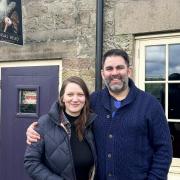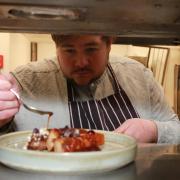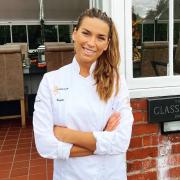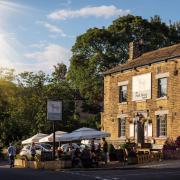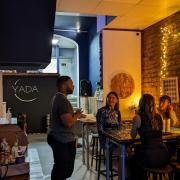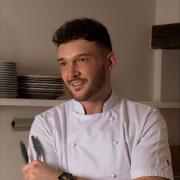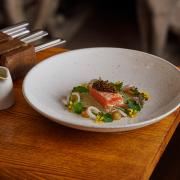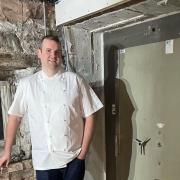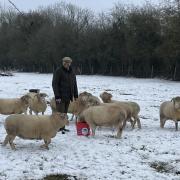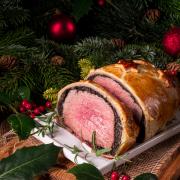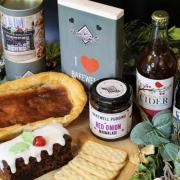Locally-sourced wine has become a reality for the village of Hathersage, which now has its very own vineyard

Michael Bailey was out for dinner at the local curry house when he overheard a conversation that made him smile. ‘I heard somebody on a different table saying, “We’ve got a vineyard in Hathersage now.” It made me feel proud, because they feel as if it’s their vineyard and it belongs to the village.’
It had been five years since Michael and his partner Mary had come up with the idea for the vineyard, which is named after and based at their home, Carr Head Farm. Perched on a south-west-facing slope looking over the Peak District village of Hathersage, it first came about as a retirement project, and has quickly become a source of village pride, as well as wine.
‘I’d been dreaming for a long time about having a field full of lavender, it was going to be heavenly,’ recalls Mary, but Michael, a former mechanical engineer, had other ideas. ‘I liked the idea of a structure and the neat rows of the lavender, but all of a sudden a vineyard seemed so much more appealing,’ he says, sitting in the couple’s traditional farmhouse kitchen. ‘And no one had done it. No one in the Hope Valley has a vineyard. It’s also 900ft above sea level so it was quite a crazy thing to do.’
He enrolled on a five-day viticulture course at Plumpton College in Essex, alongside wine producers from Cornwall and the South East with huge estates to manage. Michael’s own 1.5 acres seemed tiny in comparison, he says, and coupled with Derbyshire’s notoriously blustery and cold climate, there was a huge challenge ahead.

Undeterred, the couple used grape varieties suited to the northern hemisphere that came from plant nurseries in Germany and Luxembourg and took expert advice on how to prepare their land.
‘We’ve got four grape varieties, three white and a red,’ explains Michael. ‘They’re all varieties that grow well in cool climates. The whites are Solaris, Madeleine Angevine and Seyval Blanc, and the red is Rondo. The Seyval lends itself to making sparkling and you can blend it with the others quite well.’
The first bottles of a still white made from the Madeleine Angevine grapes arrived last year and have since been joined by a sparkling rosé and a still rosé. Produced by a professional winemaker – Staffordshire-based Halfpenny Green – Mary and Michael say their wines are primarily dry with a fruity and refreshing palate. ‘The sparkling rosé in particular makes a very nice aperitif,’ says Mary, adding, ‘it’s very clean and refreshing on the palate.’
While Carr Head is not the most northern vineyard in the country – Sheveling Wine Estates is in Holmfirth and Ryedale Vineyards is close to York – it can claim to be one of the highest. However, height is not the only unique aspect. Sitting just underneath the world-famous climbing ridge of Stanage Edge, around the corner from North Lees Hall with its Brontë heritage, and at the centre of the Peak District, there was hardly any need for marketing thanks to a steady stream of passersby.

Both Mary and Michael can often be found patiently giving vineyard tours and answering questions from curious walkers, who are often amazed to be stumbling across a vineyard in rural Derbyshire.
‘That footpath is much walked. There are very few days in the year when no one walks on it,’ says Mary. ‘We feel like we’re supplying an amenity. It’s beautiful to look at.’
But the real heart of the vineyard is the community of Hathersage. Grape picking is already a firm favourite on the village calendar with offers of help coming from all around. ‘There’s something a bit romantic about a vineyard,’ says Michael, while Mary, a renowned cook in the village, says she thinks it might be the temptation of a post-harvest lunch.
‘It is a party, it’s a bit of a carnival atmosphere. You work hard then you have fun when you stop. It’s the same with harvesting, we’ve had some good parties after that,’ she says.
Neither Mary nor Michael can tell the story of the vineyard without a peppering of anecdotes about everyone else who has been involved, from the visiting Australian artist whose watercolour sketch of the farm adorns the bottles, to a local horticulturalist who helped with the pruning.
The story behind the vineyard’s logo is a particular favourite for Mary, who had it made into a rustic sculpture after the artwork was created by her grandson, Fraser. ‘The triangle is the delta sign for change. We made it from wood covered with Derbyshire lead, because the wealth of Derbyshire was mining and lead. Then we had horseshoes to make the bunch of grapes, and copper leaves at the top.’
The couple are keen to convey a sense of shared ownership that has grown alongside the vineyard, such as the ‘Vineyard Challenge’ running race, set up by another grandson, Charlie, and taken on as an annual fixture by the local Fatboys Running Club, or the fact that at the end of each row of vines is a rose ‘belonging’ to a family member or friend.
Although Michael expects to produce up to 600 bottles after the 2018 grape harvest, most is pre-ordered by locals or sold through the licensed barn on the farm, known as the ‘pub’, and he has no plans to sell to other wholesalers. ‘We knew it wouldn’t be profitable,’ he says. ‘If you create something that looks nice, and gives people pleasure, that gives us some pleasure.
‘When we’ve finished the harvest people say to me “aren’t you proud of that?”, and I am. The other thing is, I’ve always believed strongly in the European Union and I voted to stay in, however, I’m still very patriotic, and I’m very proud that we can make wine in Britain,’ he says.
With no sign of slowing down yet, Michael and Mary have nevertheless thought about the future of the vineyard which one day won’t include them. ‘I think there’s enough interest in it locally, so I’m sure there would be ways of getting other people to take it on,’ says Michael, and Mary adds: ‘People do say this to us, because it’s there and it’s an asset, maybe it could become a village cooperative, and they’ll all run it.’






